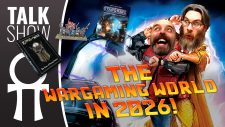Heavy Gear: Blitz
Review: Heavy Gear: small mecha, epic battles.
January 16, 2024 by labambaman
This Review Was Edited
Related Review Types
Supported by (Turn Off)
Supported by (Turn Off)
Heavy Gear is one of those franchises that has been around for a long time, but it was in 2006 that the full fledged miniatures game Heavy Gear Blitz was first released. It was a solid enough system doing what it needed to, if in some rather odd way (why all the multiplication?). It had a decent following and an impressive selection of models for a variety of factions, but it never really took off as well as it could have.
But then, sometime around 2015 or so, the second edition of Heavy Gear Blitz was released and gave the game a drastic overhaul that it needed, changing up most of the core mechanics and streamlining the game in ways that have turned what was a good game into a great game. Now on the third edition, Heavy Gear Blitz is seeing something of a resurgence and a truly excellent game waits to greet players.
Heavy Gear Blitz is what I'd call a platoon scale game, but being that it's 12mm your platoon is mostly made up of mecha and tanks. Not that infantry aren't a thing, but they aren't the stars of the show. That falls to the titular Heavy Gears, single pilot mechs that give one person the speed and firepower of a light vehicle. And these aren't the towering mechs you might see in something like Battletech, most Gears are between 13-18 feet tall and tend to try and keep as low a profile as possible. They're built for speed and rapid engagements, not brute force (well, most of them anyway).
The rules for Blitz are, as I said, great. They seem a little unintuitive at first, but that's mainly because they break away from some of the principles that plague some mainstream games. There's no phase systems here, no IGOUGO clunkiness. Using the glory of alternating activations, players go back and forth activating combat groups of models, taking each model's turn in full before moving on to the next.
Each model has a number of actions it can preform during a turn, including, but not limited to: ranged attacks, melee attacks and electronic warfare. Moving isn't an action, so a model can take an action at any point in it's activation, and if you still have movement points left over you can then keep moving the model. This means you can do tactically sound things like pop out of cover, take a shot and duck back behind cover, or dash from one piece of cover to another and taking a shot at an enemy model along the way. You can shoot and then move, move then shoot, move a little, shoot and move some more, you can bury a vibroblade in some fool's cockpit and then move to get behind cover before his buddies show up to take revenge. And models with multiple actions can do all this multiple times. Your cup floweth over with options and freedom.
Combat works quite well, if a little odd. Models have a Gunnery and a Piloting stat, and how you attack depends on which one you use for attacking (shooting uses Gunnery, melee uses Piloting). So when you attack (let's say you're shooting) you start with a base dice pool of two dice. Various things will add and subtract from this (weapons with the Burst special rule will give you extra dice, while being Crippled will have you rolling one less die for all tests for example) on both sides. Once the dice pools have been sorted both players roll their dice, and then you take the highest roll you got as your score, but you add +1 for each other die that rolled equal to or better than your stat. So if you shoot at something with a weapon with Burst 1, with a Gunnery stat of 5+ and you roll a 6, 5 and a 2, your total for the attack will be a 7. If the attacker's total is equal to our greater than the defender's (rolling against their Piloting stat) you take the difference as your Margin of Success, add that to the damage value of the weapon being used and subtract the target's armor value and that will tell you how much damage you've done to the target. It seems a little odd at first, but it's easy enough to pick up and get the hang of and offers a nice dynamic damage system where it's entirely possible to score a lucky shot and down something in a single hit.
There are a fair number of special rules in Heavy Gear Blitz, and some can be tricky to keep track of as they may have similar effects that vary ever so slightly. It's not as bad as some other games I could name, but it can be a lot. Some show up on a lot of models, like the aforementioned Burst on the most common weapons in the game, so those get hammered in pretty quickly. Others are a little more esoteric and may take a little bit to get a hang of.
If there's one area I really feel Blitz falls flat in compared to other games, it's missions. Based on the types of combat groups you take (General Purpose, Recon, Fire Support, etc.) you get access to different missions you can pick from for your side. These can range from basic objective holding to killing specific models, but some of them just feel way easier to score than others. There's one where you plant a flag and as long as it stays standing you get VP's for it. Problem is, you can just drop it right outside your deployment zone and it suddenly becomes a real problem for the other player to possibly destroy the flag and deny you those points. It's not broken, per se, but it does lean towards that "auto-include" thing that permeates poorly balanced games. I think Blitz could really benefit from some more generic missions players could easily just set up and go.
Blitz also has, as I mentioned, a rather extensive library of miniatures. Many of these are metal, just so you know up front, but there are plastic starter army sets for a good handful of the factions. The first wave of plastics (North, South, CEF and Caprice) are perhaps a tad less detailed and offer less posing options than the second wave (Peace River, NuCoal and Utopia), but to be fair they also go together way easier and are considerably less parts. While it would be nice to see the other factions currently in the game (Black Talons and Eden) get plastics, you still have a pretty good entry point for a good price. The starters will get you pretty much a full army for less than $70. A standard game is 150 Threat Value (points), and most of the boxes either get you over that or just under pretty easily. The metal models are good, solid, miniatures that I haven't had to do any pinning on yet, even with my big heavy guy with a giant rotary cannon on one arm. They go together easily enough, look great, and can be used as a weapon in case of home invasion.
Perhaps one of Blitz's biggest selling points, aside from just being a really solid game with heavy overtones of VOTOMS, is that the rules and army lists are 100% free. That's right, no cost required to check it out. You can buy print copies if you're into that sort of thing, and the two player starter sets come with a pocket edition of the rulebook in them. Add to this the excellent resource that is Gear Grinder to let you build lists and print out stat cards and you've got the makings of greatness.
Heavy Gear Blitz is a game that challenges the norms of tabletop gaming, pushes some boundaries and produces an amazing product. It's fast, dirty and brutal and no two games ever play the same. With a dedicated rules team always trying to keep the game up to date and balanced this is a game that can, and will, rapidly adapt as need be to be the best product it can be.
If you like mecha and the walking tanks of Battletech just don't do it for you, do yourself a favor and check out this game. It's got the style and the substance.




































![Very Cool! Make Your Own Star Wars: Legion Imperial Agent & Officer | Review [7 Days Early Access]](https://images.beastsofwar.com/2025/12/Star-Wars-Imperial-Agent-_-Officer-coverimage-V3-225-127.jpg)







